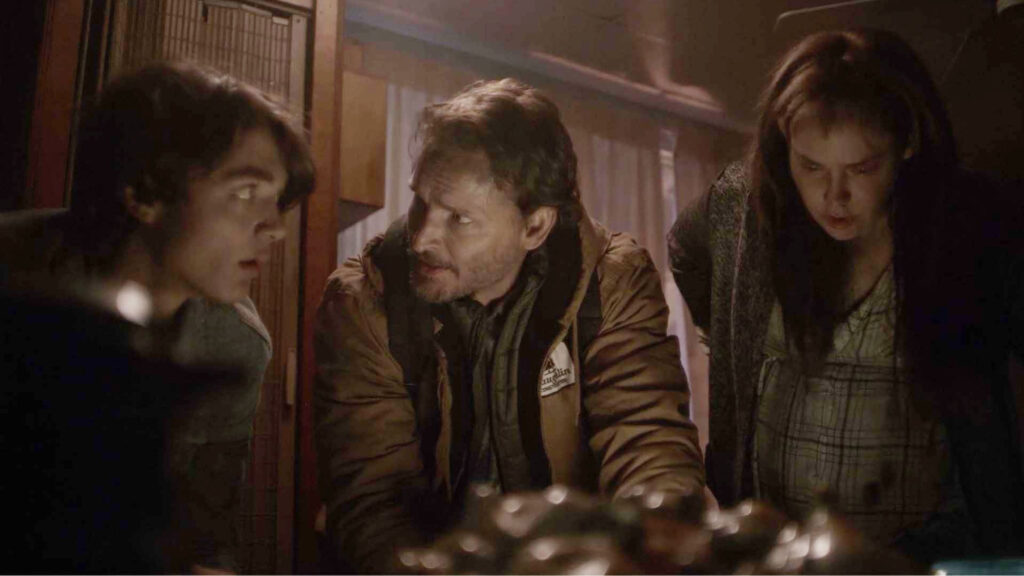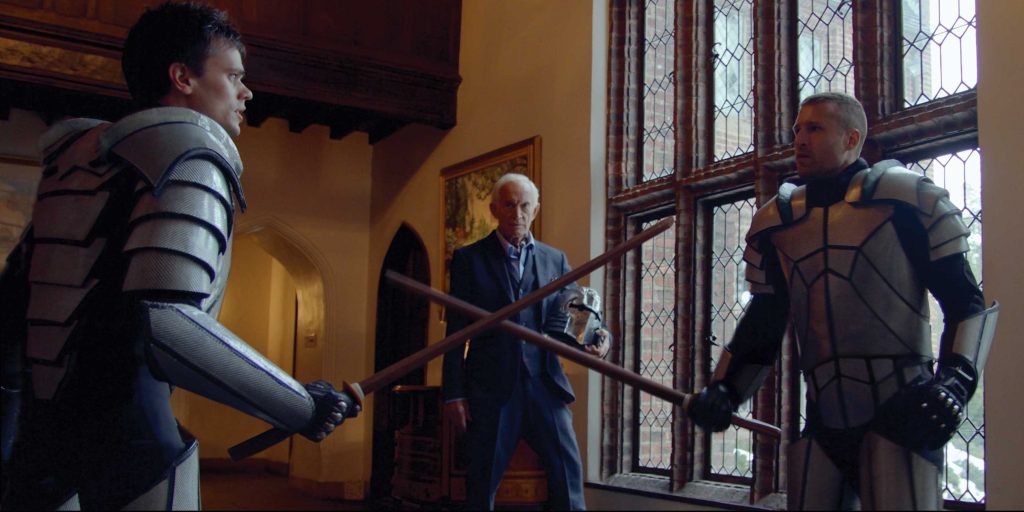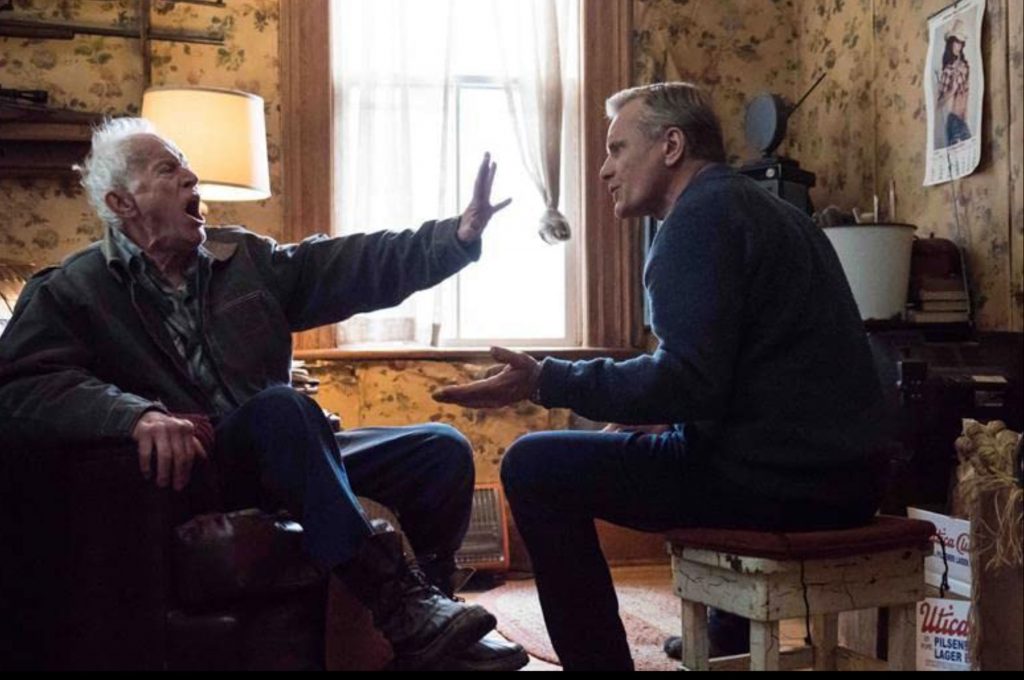February 17, 2024
by Carla Hay

Directed by Don E. FauntLeRoy
Culture Representation: Taking place in an unnamed U.S. city, the sci-fi/drama film “Altered Reality” features a predominantly white cast of characters (with a few African Americans, Asian and Latin people) representing the working-class, middle-class and wealthy.
Culture Clash: A medical research executive, whose daughter has been kidnapped and murdered, discovers a way to go back in time and change events.
Culture Audience: “Altered Reality” will appeal primarily to people who are interested in watching time-traveling movies, no matter how incoherent and poorly made they are.

Plagued by a disjointed screenplay, horrible acting and unfocused direction, “Altered Reality” is a muddled drama about time traveling and a mystery of a murdered girl. The movie concludes with an unimaginative ending that looks rushed and tacked-on, in order to pander to what the filmmakers think would be the most crowd-pleasing outcome. The only altered reality is the filmmakers thinking this low-quality film is any good.
Directed by Don E. FauntLeRoy and written by Charles Agron, “Altered Reality” takes place in an unnamed U.S. city. (The movie was actually filmed in Georgia.) It begins by showing a girl, who’s about 5 or 6 years old, sitting by herself and a table in a wooded area near her house, as she is making some drawings. Someone dressed entirely in black, including a hooded sweatshirt, appears to be stalking her.
Viewers soon find out that the girl’s name is Katy Cook (played by Quincy Faler), and she has been kidnapped by this stalker. “Altered Reality” tells the sequence of events in a very jumbled way, but viewers who are paying attention will see what led up to this kidnapping. It’s also revealed in the “Altered Reality” trailer that Katy was murdered.
Katy’s parents are a business executive named Oliver Cook (played by Agron) and a homemaker named Caroline Cook (played by Alyona Khmara), who were experiencing some marital problems even before Katy was abducted. Oliver is the owner and leader of a medical research company that is developing medication that can cure terminal illnesses. He is a workaholic who spends a lot of time away from home.
Oliver’s workaholic ways have put a strain on his marriage to Caroline and his relationship with Katy. Caroline feels neglected, and she suspects that Oliver has been cheating on her, because she notices that he gets calls and text messages on his phone from women she doesn’t know. It’s also mentioned at one point that Katy has been feeling depressed because she thinks Oliver doesn’t love her.
On the day that Katy disappeared, Oliver had promised that he would go bike riding with Katy. But instead, he backed out of that promise and was celebrating at a party with work colleagues because his company has had a major breakthrough in its research. Clinical trial results have shown that the company’s medication has cured all 5,000 people with terminal illnesses who were part of the most recent clinical trial.
In a meeting that previously took place between Oliver, the company’s cynical attorney Cooper Mason (played by Tobin Bell) and two other people named Dr. Ross (played by Demi Castro) and Spencer Ross (played by Kamran Shaikh), Oliver finds out that the medication (which comes in the form of pills) can be sold for $50,000 per pill. The company is expected to make billions of dollars after it goes public. Oliver and Cooper are understandably ecstatic, as Oliver tells Cooper how Oliver plans to spend some of these probable riches.
At the same time that Oliver was celebrating this business success at a party, Katy had been kidnapped. Caroline feels guilty because she had been looking after Katy but had taken her eyes off of Katy for only a few minutes. Caroline frantically tried to reach Oliver by phone many times after Katy went missing, but he ignored her messages because he was too busy partying with his colleagues.
Oliver eventually gets Caroline’s messages and rushes home. But it’s too late. Katy has disappeared, and there are no clues about who kidnapped her and why. The movie shows that nine months later, Katy kidnapping is still a mystery, with no progress in the case, although Oliver eventually finds out that Katy has been murdered.
In the nine months since the kidnapping, Oliver has become very wealthy because of his company’s “miracle drug.” However, Oliver and Caroline are heartbroken and feel guilty over the disappearance of Katy and have not given up hope of finding her. The marriage of Caroline and Oliver has been unraveling because Oliver has been coping with his grief by spending even more time away from home than he did before Katy’s kidnapping.
One of the things that Oliver did after he became rich is buy a bed-and-breakfast resort called Spring Manor, a place that has happy memories for him because he has been going there every year since he was a child. Oliver continued the tradition after he became a husband and father. His attorney Cooper advised that Oliver should not buy Spring Manor, which Cooper described as “a bottomless pit of repair bills,” but the sentimental value of Spring Manor had too much appeal to Cooper, so he bought the property anyway.
The Spring Manor parts of the plot are among the weakest links in an already poorly constructed screenplay. At Spring Manor, Oliver has been friendly for years with the manor’s elderly custodian Jack (played by Lance Henriksen), who is obviously a ghost, as viewers see when Jack shows an ability to vanish and appear suddenly. Oliver is so unobservant, he doesn’t think it’s strange that Jack appears out of nowhere like a ghost.
Jack also claims to have known Oliver’s ancestors who died hundreds of years ago. Oliver marvels out loud to Jack about how Jack has looked the same the entire time that Oliver has known Jack. “How do you do it?” Oliver asks Jack about why Oliver doesn’t seem to get older. Jack replies, “I see a lot of strange things here.” Oliver says, “It’s the energy of this place.”
As soon as these things are revealed, you just know that Jack has some secrets that have to do with Oliver’s ancestors, and there will be a time-traveling element that centers on Spring Manor. The cinematography lighting turns brown in the time-traveling scenes. It’s all so hokey and predictable. The musical score by Andrew Morgan Smith is trying to evoke noirish thrillers from the 1950s, but it sounds very out-of-place in a movie that takes place mostly in the 2020s.
One day, Oliver and Jack are having a private conversation outside at Spring Manor. Jack takes out a pill bottle after Oliver says he has a headache, and he gives Oliver a pill. Jack tells Oliver to take the pill only after Oliver finds out what the ingredients are. Oliver says he’s had these headaches for a while—and the reason why he has these headaches is the most obvious reason when Oliver predictably finds out that he can time travel. It takes an awfully long time in the movie (after two-thirds of the movie have passed) before he discovers this time-traveling ability.
After Oliver gets this pill from Jack, there’s trouble in the Cook household when Oliver comes home to find out that a woman (whose face isn’t on camera in this scene) is in the living room, is claiming to be Oliver’s mistress, and has exposed their alleged affair to Caroline. This self-described mistress shows Caroline proof on her phone that Oliver has been cheating on Caroline. Caroline is devastated and immediately tells Oliver that she wants a divorce. This scene is shown early in the movie’s jumbled timeline, and the scene is revisited much later to reveal the identity of this “mistress.” This identity reveal is also no surprise.
Oliver is so distraught over Caroline wanting a divorce, he becomes suicidal. Before he goes somewhere with the intent to hang himself, he stops off at a strip club and gives a wad of cash to a stripper named Brittany, whose stage name is Vixen (played by Kayla Adams), and he tells her to use to money for the future college education of Brittany’s underage daughter. Oliver met Brittany on the night he went to this strip club with Cooper and Cooper’s date Alex Parker (played by Krista Dane Hoffman, also known as Krista Dane King), a seductive fashion executive who happens to know Caroline casually because they’re in the same yoga class.
All of these storylines and subplots are shown or explained in a very messy way in “Altered Reality,” which clumsily mishandles flashbacks with sloppily edited scenes that take place in the present day. There’s also a pivotal plot development involving someone from the past named Kate (played by Kate Reilly), who has a personal connection to certain people in the story. Ed Asner shares top billing in “Altered Reality,” but his screen time in the movie (as Jack’s family member Mike Wilson) consists of less than five minutes.
As the writer, star and one of the producers of “Altered Reality,” Agron looks like he made a vanity project, because his acting performance is among the worst in a movie filled with bad acting. The movie tries to blend several different story ideas into one big concept, but it just doesn’t work, like pieces of a puzzle that don’t fit. Even without all the plot holes and unanswered questions, “Altered Reality” is a very dull movie that’s supposed to be a sci-fi thriller but is really just a sci-fi clunker.
K Street Pictures released “Altered Reality” in select U.S. cinemas on February 16, 2024.






